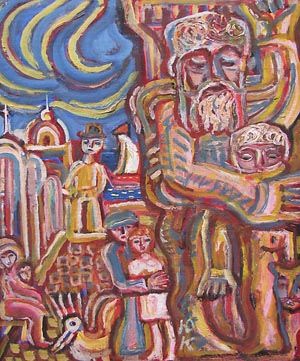A dreamy, bearded man
Large-scale exhibition of works by modernist painter Yurii Kovalenko (1931-2004) opened in Odesa Museum of Modern Art
Odesa — A wonderful, unique master, philosopher, poet and... hooligan organically united in his art the Ukrainian folk tradition, the mentality of southern painting and the Leningrad theater-art school. The exhibition is called “The selected.” It is dedicated to the 80th anniversary of the master and the third anniversary of the youngest of Odesa’s museums. The exposition is set out in four rooms and includes paintings, graphic works and sculptures from a half-century of creative work (from 1948). The presented works are taken from the funds of the Odesa Museum of Modern Art (OMMA) and from 20 private collections of Odesa and Kyiv (the curator of the project is the son of deceased artist, Andrii Kovalenko, already quite a distinguished artist, who now pursues the best traditions of his father’s painting). The disciple of the Odesa Drama Art College and the Leningrad Drama, Music and Cinematography Institute, Kovalenko synthesized in his creativity monumentalism and the colorful discipline of the “strict style,” with decorative approaches of theater art. Finally, he created his own world of folk images, a style that combined folk primitivism, southern colorism and vividness, with powerful expression. In his style the artist is close to Edvard Munch and Marc Chagall, among the expressionists and avant-gardists (with a tendency to dramatize the plot or flow into a world of childish fantasies) and to Lemko Drovniak (Nykofor), among the primitivists. Although Kovalenko considered himself a city resident, his works retain a strong connection with nature and earth, which is typical mainly for village natives (he was born in Pryluky, Chernihiv oblast). How-ever, his comprehension of plots and images, and their interpretations does not lack irony and reflection, an abundance of approaches that can develop only in an urban culture. People who knew the artist closely believe that he acutely felt the problem of social adaptation, typical of nonconformists. This, by the way, is mentioned in the novel-essay The Man from Tiraspol Street (2000) by Odesa’s local historian and publicist Oleh Hubar. As of today, it is the only literary work about the artist.
The pictorial canvases of the artist are written with a single emotional impulse. They are ingenuous, filled with feeling, organic and complete. There is something musical in these works — the length in time and endless variations. Music was also important for the artist, namely folklore and classical — Sibelius, Stravinsky and others. He also liked crowds, cheerful carelessness, co-lorful festivities and an excess of emotions. This is reflected in such works as Troika, On the Road, Brides and others. In his life, Kovalenko was as well joyful, untroubled and sometimes mockingly-ironic. In his appearance he resembled the wise Socrates. Most of all he loved to draw horses and cats, which grew to a level of anthropomorphic beings, and also children and grandparents (the latter were mainly self-portraits). There is a notable bronze sculpture of Kovalenko by Oleksandr Tokarev (OMMA). The sculptor appositely depicted the childishly carefree, dreamy, bearded man sitting on a lawn and contemplating the sky. This image resembles either a stoic philosopher or a fairy-tale dwarf. The artist’s works also comprise fantastic sculptures (wood, stone, wire), archaic in form, warm and earthly in their attitude (The Abduction of Europa, An Old Woman and a Child, The Cock, etc.). Kovalenko has also left behind poetry, some of which was published in his album of graphics and poems (2004). It was printed by friends and admirers of the artist’s creativity. For some time, Kovalenko combined professional artistry with teaching at an art college, and with work in the Ukrainian and Opera theaters of Odesa. Apart from private collections, there is a beautiful collection of Kovalenko’s works at the Odesa Art Museum and the aforementioned Odesa Museum of Modern Art, which are doing their best to popularize the artist’s creative heritage.






